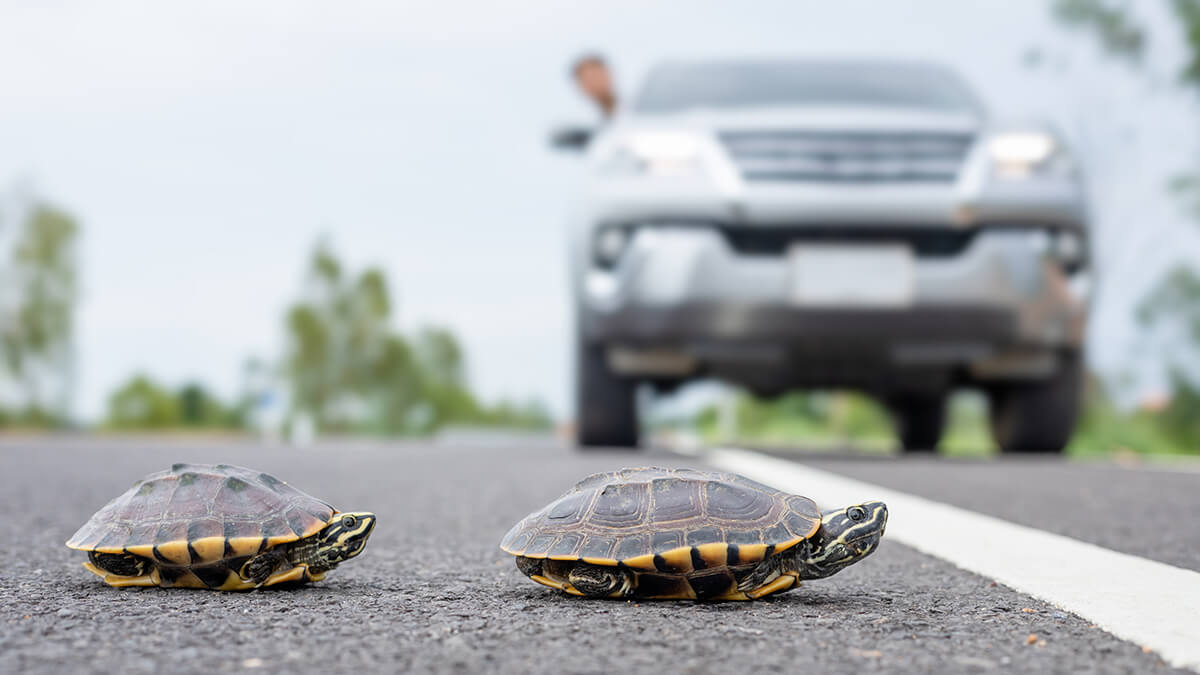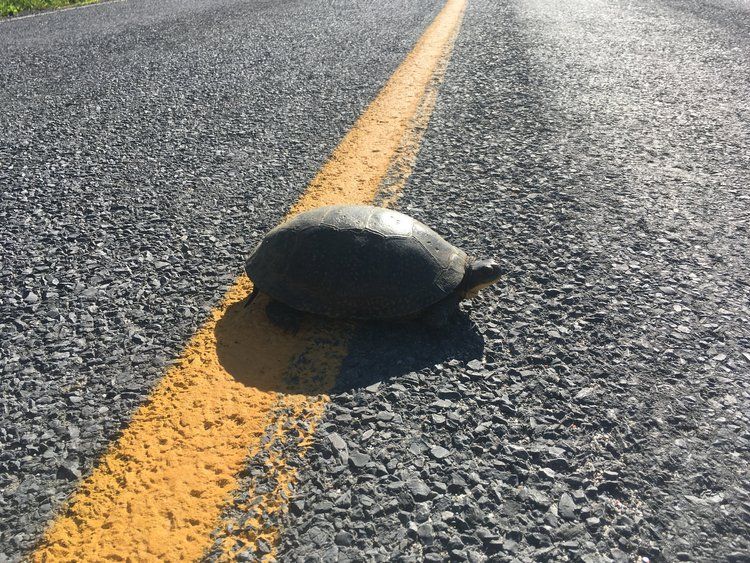Turtles cross roads to reach nesting sites or seek food, often due to habitat fragmentation. Turtles, like many other animals, face challenges when crossing roads due to habitat fragmentation caused by human development.
This can lead them to venture onto roads in search of nesting sites or food sources. Unfortunately, this puts them at risk of being hit by vehicles, leading to a high mortality rate among turtle populations. Understanding why turtles cross roads is crucial in implementing measures to protect these vulnerable creatures and preserve their habitats.
By raising awareness and taking steps to mitigate the impact of roads on turtle populations, we can help ensure their survival for future generations to come.
The Importance Of Understanding Turtle Behavior
Migration Patterns
Turtles have specific routes they follow when moving from one place to another.
Understanding these patterns helps protect them from road accidents.
Nesting Habits
Turtles lay their eggs in sandy areas near water bodies.
By knowing their nesting habits, we can create safe zones for them.
Credit: www.newtownbee.com
Challenges Faced By Turtles When Crossing Roads
When turtles try to cross the road, they face various challenges, which make their journey dangerous and sometimes fatal. Let’s explore the main challenges that turtles face while crossing roads:
Traffic Hazards
One of the biggest challenges that turtles face when crossing roads is traffic hazards. Turtles are slow-moving creatures and cannot move fast enough to avoid oncoming cars. In addition, turtles have a low profile, and drivers often cannot see them until it’s too late. As a result, thousands of turtles are killed each year by vehicles on roads.
To avoid traffic hazards, turtles must cross roads during low traffic times, which are usually early in the morning or late at night. However, even during these times, turtles are still at risk of being hit by cars. Drivers should be aware of turtles on the road and slow down or stop to let them pass.
Predators
Another challenge that turtles face when crossing roads is predators. Turtles are vulnerable to predators, such as birds, raccoons, and foxes, when they are on the road. Predators see turtles on the road as an easy target and can quickly snatch them up before they have a chance to escape.
To avoid predators, turtles must cross roads quickly and make it to the other side as fast as possible. However, this is not always possible, especially if the road is busy or if the turtle is injured. In such cases, turtles become easy prey for predators.
It’s important to note that turtles play a vital role in our ecosystem, and their loss can have a significant impact on our environment. By understanding the challenges that turtles face when crossing roads, we can take steps to protect them and ensure their survival.
Human Impact On Turtle Populations
Human activities have a significant impact on turtle populations, especially when it comes to their interactions with roads. The expansion of human infrastructure and urban development has led to habitat fragmentation, increased road mortality, and a decline in turtle populations. Understanding the reasons behind why turtles cross roads can shed light on the ways in which human activities impact their survival.
Habitat Fragmentation
Habitat fragmentation occurs when roads and other structures divide turtle habitats, making it challenging for them to move between different areas for feeding, breeding, and nesting. This fragmentation can lead to isolation of turtle populations, reducing genetic diversity and increasing their vulnerability to environmental changes.
Road Mortality
Road mortality is a major threat to turtle populations. As turtles attempt to cross roads to reach nesting sites or foraging areas, they often fall victim to vehicle strikes. This high mortality rate can significantly impact local turtle populations, especially in areas where roads intersect their natural habitats.

Credit: www.foremost.com
Efforts To Protect Turtles During Road Crossings
Eco-passages
Eco-passages are specially designed underpasses or culverts that allow turtles and other wildlife to safely cross under roads. These passages are strategically placed in areas where turtles are known to migrate, ensuring safe passage without the risk of being hit by vehicles. Eco-passages are an effective way to minimize the impact of roads on turtle populations and are a key component of conservation efforts.
Volunteer Initiatives
Volunteer initiatives play a crucial role in protecting turtles during road crossings. Local conservation groups and volunteers often organize efforts to monitor turtle migration patterns, identify high-risk areas, and implement measures to protect the turtles. This can include setting up temporary barriers, signage, and even direct assistance in helping turtles safely cross the road. Volunteer initiatives not only help protect turtles but also raise awareness and foster a sense of community involvement in wildlife conservation.
Success Stories In Turtle Conservation
Community Involvement
Local communities play a crucial role in turtle conservation efforts. By raising awareness and actively participating in rescue and rehabilitation programs, communities have significantly contributed to the protection of turtle populations. Through educational initiatives and community-led conservation projects, people have become more invested in safeguarding turtle habitats and reducing road mortality.
Legislative Measures
Government legislation has been instrumental in mitigating the threats faced by turtles crossing roads. By implementing road signs, speed limits, and designated turtle crossing areas, legislative bodies have taken proactive steps to reduce turtle fatalities. Additionally, the enforcement of wildlife protection laws and penalties for harming or disturbing turtles has bolstered conservation efforts and promoted responsible behavior among motorists.

Credit: khqa.com
Educational Campaigns For Raising Awareness
When it comes to understanding the reasons behind turtles crossing the road, educational campaigns play a crucial role in raising awareness and promoting conservation efforts. These campaigns aim to educate the public about the risks turtles face when crossing roads and highlight the importance of taking action to protect these vulnerable creatures.
School Programs
School programs are an effective way to engage young minds and instill a sense of responsibility towards wildlife conservation. These programs can include interactive workshops, presentations, and hands-on activities that teach students about the habitats and behaviors of turtles. By fostering an appreciation for these animals at a young age, school programs contribute to building a generation of environmentally conscious individuals.
Social Media Campaigns
Social media platforms provide a powerful medium for spreading awareness about turtle conservation. Through captivating visuals, informative posts, and engaging videos, social media campaigns can reach a wide audience and spark conversations about the importance of protecting turtles. By leveraging hashtags and user-generated content, these campaigns have the potential to create a ripple effect, inspiring people to take action and make a difference.
Future Prospects For Turtle Conservation
Turtles often cross roads in search of nesting grounds, risking their lives in the process. To ensure their survival, conservation efforts focus on creating safe passages and raising awareness about the importance of protecting these endangered creatures.
Turtles are one of the most fascinating and ancient creatures in the world. They have survived for millions of years and have been an essential part of the ecosystem. However, the alarming rate at which turtles are disappearing is quite concerning. As a result, the scientific community is working hard to find ways to preserve these beautiful creatures. In this section, we will discuss the future prospects for turtle conservation, focusing on technological solutions and research initiatives.Technological Solutions
One of the technological solutions that have been implemented to protect turtles is the use of GPS trackers. These trackers help scientists to track the movement of turtles and gain information about their habitat and migration patterns. This information helps in developing conservation strategies and identifying areas that are critical to the survival of turtles. Additionally, scientists have also developed specialized cameras that can be attached to the shells of turtles to monitor their behavior and study their interactions with the environment. Another technological solution is the use of drones to monitor turtle populations. Drones can help scientists cover large areas quickly and efficiently, providing a more comprehensive understanding of turtle populations. The use of drones can also help locate nesting sites and track the movements of turtles during breeding season.Research Initiatives
Research initiatives are essential for understanding the biology, behavior, and ecology of turtles. One such initiative is the use of genetics to study turtle populations. Genetic studies help to identify different species and subspecies of turtles, as well as their geographic distribution. This information is important for developing conservation plans and identifying areas that need protection. Another research initiative is the study of turtle behavior. This involves observing turtles in their natural habitat and collecting data on their movements, feeding habits, and interactions with other species. Such research provides valuable insights into the ecology of turtles and helps in developing conservation strategies. In conclusion, the future prospects for turtle conservation are bright. With the implementation of technological solutions and research initiatives, we can gain a better understanding of these fascinating creatures and protect them from extinction. It is essential that we continue to work towards the conservation of turtles and ensure that they remain an integral part of our ecosystem for generations to come.Conclusion
The reasons turtles cross roads are complex. Understanding their behavior and habitats is crucial for conservation efforts. By being aware and taking action, we can help protect these fascinating creatures. Together, we can make a difference in ensuring their safety and well-being.






Leave a Reply